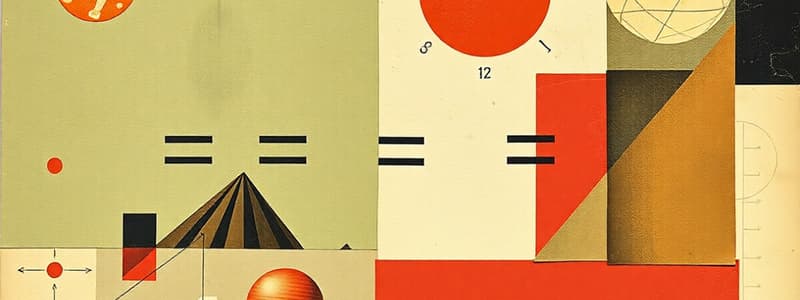Podcast
Questions and Answers
What is one-to-one correspondence and why is it important in counting?
What is one-to-one correspondence and why is it important in counting?
One-to-one correspondence is the ability to match each object with one numeral, ensuring accurate counting. It is crucial because it helps establish a solid foundation for understanding numbers.
Give an example of a basic addition problem and explain the concept behind it.
Give an example of a basic addition problem and explain the concept behind it.
For example, $2 + 3$ can be represented by combining two apples and three apples to find a total of five apples. This demonstrates how addition combines sets of objects.
Name three basic shapes and provide one property for each.
Name three basic shapes and provide one property for each.
Square (four equal sides), circle (no corners), and triangle (three sides). These properties help classify shapes.
What are informal units of measurement, and why are they used?
What are informal units of measurement, and why are they used?
How can students identify and continue a simple repeating pattern?
How can students identify and continue a simple repeating pattern?
What steps should students take when solving a simple word problem?
What steps should students take when solving a simple word problem?
What are tally marks and how are they used in data handling?
What are tally marks and how are they used in data handling?
Explain the concept of place value for numbers up to 20.
Explain the concept of place value for numbers up to 20.
Flashcards
Number Recognition
Number Recognition
Learning to identify and write numbers from 0 to 9.
Counting Objects
Counting Objects
Matching numbers to objects, from 1 to 20, one-to-one.
Addition Facts
Addition Facts
Combining objects or numbers to find a total.
Subtraction Facts
Subtraction Facts
Signup and view all the flashcards
Basic Shapes
Basic Shapes
Signup and view all the flashcards
Place Value (up to 20)
Place Value (up to 20)
Signup and view all the flashcards
Simple Word Problems
Simple Word Problems
Signup and view all the flashcards
Data Collection
Data Collection
Signup and view all the flashcards
Study Notes
Number Recognition and Counting
- Students learn to recognize numerals from 0 to 9.
- They practice counting objects from 1 to 20.
- Establishing one-to-one correspondence between objects and numbers is crucial.
Addition and Subtraction
- Introduction to basic addition facts using concrete objects and pictorial representations (e.g., combining sets of objects to find the total).
- Introduction to basic subtraction facts - understanding the concept of taking away.
- Visual aids (e.g., number lines, ten frames) are common tools to develop these skills.
- Problems are often presented in story contexts to make them relatable.
Geometry
- Recognizing and naming basic shapes like squares, circles, triangles, and rectangles.
- Identifying and classifying shapes based on their properties (e.g., number of sides, corners).
- Simple spatial reasoning activities, such as arranging shapes.
Measurement
- Comparing lengths, heights, and weights using informal units like pencils, books, and paperclips.
- Introduction to standard units, though not extensively covered.
Patterns
- Identifying and continuing simple repeating patterns using objects, shapes, and numbers.
- Developing visual pattern recognition skills.
Problem Solving
- Introducing simple word problems within relatable contexts.
- Guiding students through problem-solving steps such as understanding the problem, planning a solution, and verifying the answer.
- Practical application of addition and subtraction concepts presented in problem-solving scenarios.
- Emphasis on understanding the problem statement rather than just finding the answer.
Data Handling
- Basic data collection using tally marks.
- Presenting data using simple pictographs.
- Introduction to the concept of representing data in organized form.
- Using data to make observations and draw simple conclusions.
Place Value
- Introduction to the concept of place value for numbers up to 20.
- Understanding the value of each digit in a number (ones and tens).
Money
- Identifying standard Indian currency notes and coins.
- Simple transactions using money (in context).
- Introduction to concepts like counting money and simple transactions.
Studying That Suits You
Use AI to generate personalized quizzes and flashcards to suit your learning preferences.




